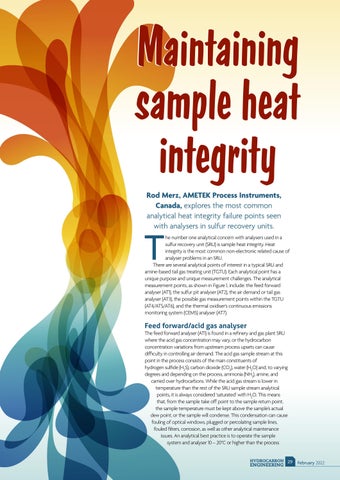Rod Merz, AMETEK Process Instruments, Canada, explores the most common analytical heat integrity failure points seen with analysers in sulfur recovery units.
T
he number one analytical concern with analysers used in a sulfur recovery unit (SRU) is sample heat integrity. Heat integrity is the most common non-electronic related cause of analyser problems in an SRU. There are several analytical points of interest in a typical SRU and amine-based tail gas treating unit (TGTU). Each analytical point has a unique purpose and unique measurement challenges. The analytical measurement points, as shown in Figure 1, include: the feed forward analyser (AT1), the sulfur pit analyser (AT2), the air demand or tail gas analyser (AT3), the possible gas measurement points within the TGTU (AT4/AT5/AT6), and the thermal oxidiser’s continuous emissions monitoring system (CEMS) analyser (AT7).
Feed forward/acid gas analyser The feed forward analyser (AT1) is found in a refinery and gas plant SRU where the acid gas concentration may vary, or the hydrocarbon concentration variations from upstream process upsets can cause difficulty in controlling air demand. The acid gas sample stream at this point in the process consists of the main constituents of hydrogen sulfide (H2S), carbon dioxide (CO2), water (H2O) and, to varying degrees and depending on the process, ammonia (NH3), amine, and carried over hydrocarbons. While the acid gas stream is lower in temperature than the rest of the SRU sample stream analytical points, it is always considered ‘saturated’ with H2O. This means that, from the sample take off point to the sample return point, the sample temperature must be kept above the sample’s actual dew point, or the sample will condense. This condensation can cause fouling of optical windows, plugged or percolating sample lines, fouled filters, corrosion, as well as other analytical maintenance issues. An analytical best practice is to operate the sample system and analyser 10 – 20°C or higher than the process HYDROCARBON 29
ENGINEERING
February 2022
